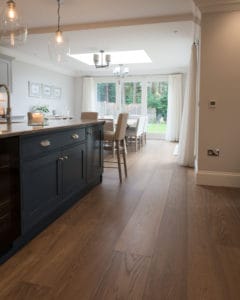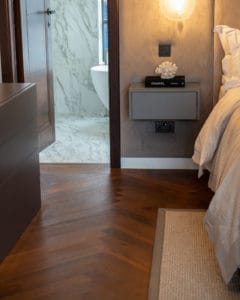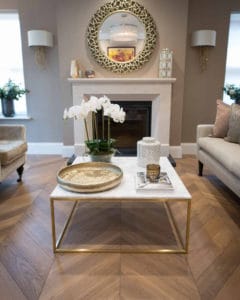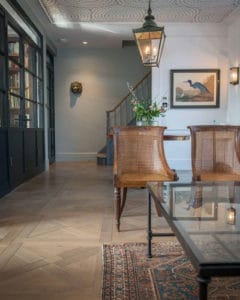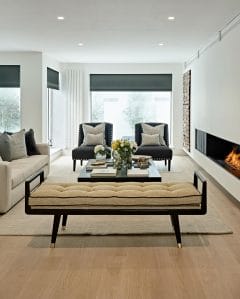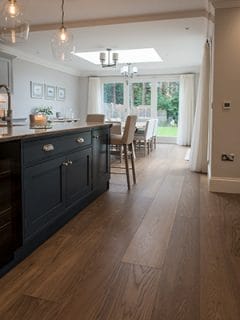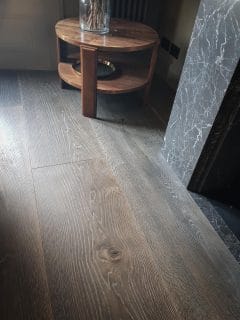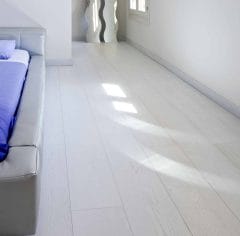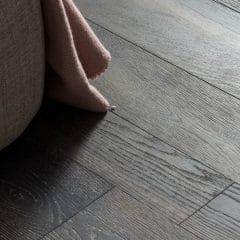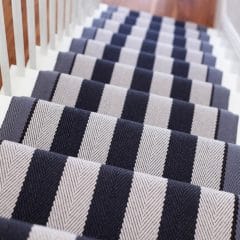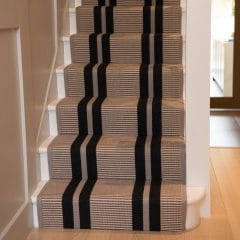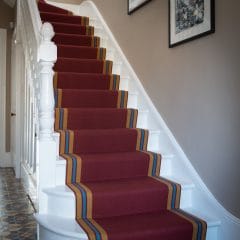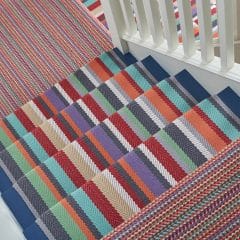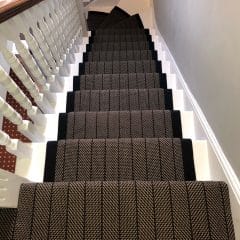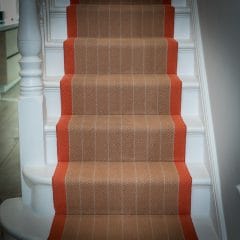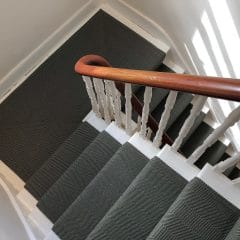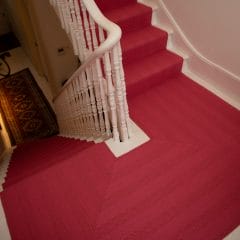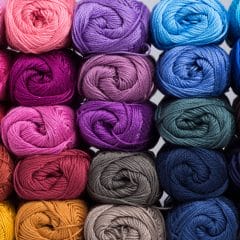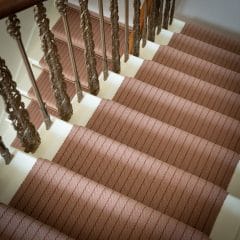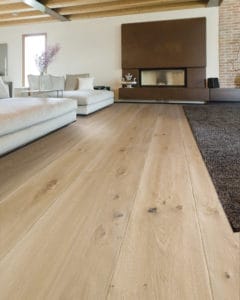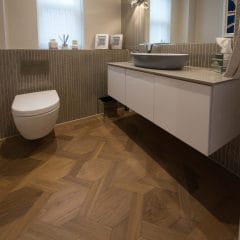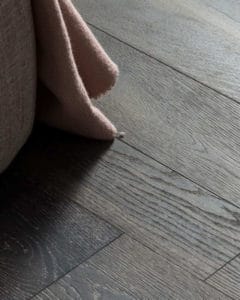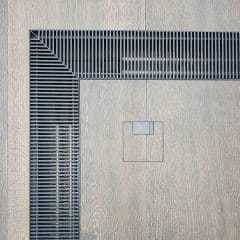What is the best wood floor finish
Table of Contents
Why wood floors need protection
Wood is hygroscopic (a material that readily absorbs water), left untreated wood floors are susceptible to staining and moisture ingress resulting in rotten timber and reduces the lifespan of the floor. Applying and maintaining a finish on your wood floor is an important process to keeping your house in good condition. A well finished and maintained wood floor will not only protect the timber but will also provide a safe and clean surface free from bacteria and infestation from insects. Keeping the surface in excellent condition will maintain the elegant figuring and colour of the wood. It’s easy to spot a poorly finished or maintained wood floor as you will see black in the grain and edges become fragile and prone to chipping.
Understanding the different types of floor finishes is an important factor when buying a wood floor or choosing a finish if sanding and sealing an old floor. Some finishes have a distinct look and feel to the floor and all have their own way of being maintained. So choosing wisely will make all the difference in the years to come.
Always follow the manufacturers’ instructions and test a small area first to make sure you are happy with the finish.
Natural Oil (Impregnating Oils)
Natural oils impregnate deep into the wood finish to give long lasting and durable protection. Ingredients are very natural which can include Tung oil, Linseed oil and rosin. Most impregnating oils can be further enhanced with a final finishing product to seal the pores. Products to be used for final finishing can include natural beeswax, hardwax oil or lacquers.
Drying and Curing Time
Most natural oiled flooring require 2 coats with 12-24 hours drying time between coats depending on the humidity. The finish will continue to harden for at least 2 weeks after following the final coat so do not cover with floor protection sheets or rugs immediately after the final coat dries.
Maintenance:
Regular refresher oils should be applied with either a maintenance product. This could be every 2 years or for a high traffic area such as hallways and kitchens every 6 months to a year. Natural Impregnating Oils offer more choice in products used to maintain the finish. The final finishing product used to seal the floor will dictate the maintenance product to use.
Products:
- Chimiver LIOS BIOIL Natural
- Saicos Wood Impregnation biocide-free
- Berger Seidle Classic Baseoil
Benefits:
- Natural look and feel
- Eco friendly and low in VOCs
- Long lasting
- Deep protection into the wood pores, provides higher stain resistance than hardwax oil
- Easy to spot repair
Negatives:
- Clear and lighter colours can yellow/change colour over time, although maintenance products with white piments can minimise this effect
- Requires slightly longer drying time than hardwax oils, not as quick as varnishes/lacquers
- Requires regular maintenance oil
Hardwax Oil (semi penetrating oil)
Hardwax Oils are natural oils and waxes mixed with solvents and have become incredibly popular since the 1990’s. They are widely available in DIY stores and popular with finishing contractors and flooring manufacturers. The concept of these oils is the natural oils penetrate the pores and solvents harden the waxes on the surface to protect the floor. The oil and solvent ingredients vary from manufacturer to manufacturer. The key ingredients include vegetable oils such as Linseed Oil, Tung Oil, Castor Oil mixed with Carnauba Wax, Beeswax and a solvent such as Paraffin and Siccatives.
The solvent element helps speed up the curing time for the oils to dry (harden). Products with high solid content will retain more of the oil properties during the curing process and thus provide greater protection to the floor.
Drying and Curing Time
Most hardwax oils require 2 coats with 6-10 hours drying time between coats depending on the humidity. The finish will continue to harden for at least a week after following the final coat so do not cover the floor with protection sheets or rugs immediately after the final coat dries.
Maintenance:
Regular refresher oils should be applied with either a maintenance oil (a more diluted form of the hardwax oil) or the full Hardwax oil at regular intervals. This could be every 2 years or for a high traffic area such as hallways and kitchens every 6 months to a year.
Products:
- Blanchon Hard Waxoil
- Osmo Polyx Oil
- Berger HardOil
Benefits:
- Natural look and feel
- Wide choice of colours and gloss levels
- Widely available with many contractors familiar with its application
- Eco friendly and low in VOCs
- Easy to spot repair
- Long lasting if maintained with maintenance oils
Negatives:
- Clear and lighter colours can yellow/change colour over time, although maintenance products with white piments can minimise this effect
- Although fairly quick drying times, not as quick as varnishes/lacquers
- Requires regular maintenance oil
UV Oil
UV cured oil is a factory finished wood floor product. The curing process uses UV lamps to speed up the process removing the need for planks to be stored on drying racks between each coat. The UV does not give the floor protection from UV light, rather it is the method used to cure and dry the oils. It should be noted that some UV oiled floors will have had acrylic added to the oil to aid the drying process, this in turn reduces the ability to re-oil the floor and negates the benefit of an oiled finish. Newer and premium UV cured oiled floors allow for maintenance to carried out the same as an oxidative (air dried) oiled floor. You should ask your supplier to confirm the maintenance process before buying a UV oiled floor.
Maintenance:
Varies depending on the formula used. If acrylic UV oiled finish then cleaning only. If the finishi is the maintainable UV Oil type regular refresher oils should be applied with either a maintenance oil (a more diluted form of the hardwax oil) or the full Hardwax oil at regular intervals. This could be every 2 years or for a high traffic area such as hallways and kitchens every 6 months to a year.
Benefits:
- Wide choice of colours and gloss levels
- Eco friendly and low in VOCs
- Easy to spot repair for some types of UV Oil
- Long lasting if maintained with maintenance oils
Negatives:
- Clear and lighter colours can yellow/change colour over time, although maintenance products with white piments can minimise this effect
- Can be difficult to spot repair if Acrylic type
- Requires regular maintenance oil to be applied
Beeswax
Beeswax is one of the oldest forms of protecting a wood floor and provides the most beautiful lustre of all finishes. Incredibly natural supporting growth of bee populations.. If you grew up in the 1980s or earlier you may remember the use of buffing machines to polish wood floors with wax. Technical advances in floor finishes with lower maintenance and greater protection to floors meant that waxed floors have become less popular. However waxed floors certainly have their place as a floor finish. If you love the tactile feel and sheen of a waxed floor and don’t mind the regular maintenance then a bees waxed floor is worth considering.
Beeswax should not be used on untreated wood, it should be used as a finishing/maintenance product. Thus applying natural impregnating oil then beeswax will provide best protection for you your floor. Historically shellac would have been used first and then waxed. Some manufactures have modified beeswax products that can be used on untreated wood
Drying and Curing Time
Beeswax should be applied with with a cloth and left for 30 to 60 minutes to allow the wax to set and harden before buffing to produce its silky sheen look. after buffing the floor can be walked on.
Maintenance:
Beeswax floors required regular maintenance and recommend investing in a buffing machine to polish the floor with additional beeswax or a modified beeswax polish. Floors may need polishing once a month depending on traffic. Over time wax build up will need to be removed with a wax polish remover.
Benefits:
- Natural product
- High level of protection
- Soft to touch and highlights natural colours of the timber
- Natural gloss sheen
- Eco friendly
Negatives:
- High maintenance
- Not ideal in kitchens as water marks can show (watermarks can be buffed out)
- Difficult to remove wax or change finish
Products:
- Fiddes Supreme Wax Polish
- Briwax Original Wax Polish
Lacquer (varnish)
Lacquers and varnishes are considered to be the same. Technically there is a difference with varnishes consisting of oils, resin and solvents. However with ever evolving technology varnish is not used today as they tend to crack and reduce its effectiveness as a protective finish. Today the word varnish and lacquer have the same meaning with lacquer widely used in the UK and Varnish used in continental Europe. The principle concept with lacquers is that they produce a surface layer of protection rather than penetrating into the timber like oil based finishes
Factory finished or on-site finished?
Water Based Polyurethane Lacquer
Modern technology has produced lacquers that are water based and thus have very low VOC content and do not yellow. They are softer than oil based varnishes but this is offset with applying more layers. If you are buying a prefinished floor do ask how many layers are applied as this will highlight the quality of the product. Water based Polyurethane lacquers are more expensive but do offer the best quality above other types of lacquers. At Urbane Living our lacquered floors are water based with a primer and then 8 coats of water based polyurethane lacquer and can provide 30+ years of protection in a residential environment if well maintained.
Drying and Curing Time (when finished on site)
Generally 3 hours drying time between coats and cured 8 hours after final coat
Maintenance:
Lacquer floors require the least amount of maintenance and the finish will remain protective for many years. Polish and refresher products can be applied to provide extra protection and fill minor surface scratches. Larger scratches can be repaired with wax sticks and touch up kits.
Benefits:
- Very hard wearing
- Improves colour of the wood
- Non yellowing
- High protection
- Easy to maintain
- Ultra matt to high gloss
Negatives:
- Expensive
- Patch sanding and finishing not possible (it is easier to cut out and replace a plank)
Products:
- Bona Mega, Traffic
- Morrells Induro XL1
Conclusion and verdict
At Urbane Living we take the view that finishes need to be durable, look good and be eco friendly. Being that the needs of our clients vary with some more concerned how they look and others prioritising asthetics there is no single answer to say which is overall best. Thus the best finish needs to be grouped into 3 categories:
Look and feel
- Beeswaxed floors have an incredible look and feel and bring out the colour of the wood very well, however they do require high maintenance.
- Natural Oil for natural feel to the floor
- Water based Lacquer for depth and richness in colour
Durability
- Water based Lacquer are ideal for high traffic areas or installed during building projects as builders dust, spills and paint less likely to be an issue
- Natural Oiled close second if properly maintained
Ease of Maintenance
- Water Based Lacquers (although not possible to patch repair) as they dont need regular oiling









